
In Washington, D.C. there are a few facts of life and one of them is that since its inception more than a century ago, the debt ceiling one way or another will be increased. Often that will be done on a bipartisan basis under regular order, usually requiring 60 votes in the Senate for passage, thus requiring compromises in order to get it across the finish line.
But in 2025 House and Senate Republicans have instead opted to include the debt ceiling in the budget reconciliation bill that will also extend and expand President Donald Trump’s 2017 tax cuts, include new measures for border security and codify the President’s executive orders.
Speaking at a press conference on May 6, House Speaker Mike Johnson outlined that the House would be putting into law some of President Trump’s budget-related executive orders: “we’re going to codify dozens more of President Trump’s budget-related executive orders, spending-related executive orders through the budget reconciliation process.”
And Republicans, like they did during the Bush and Trump administrations, are using budget reconciliation to get their tax cuts done. And this time to get some of their favored approaches to border security and spending cuts enacted as well. Why?
Because if these items came up under the Senate filibuster, Democrats would block them, either demanding concessions for passing them, or more likely just defeating them completely.
And so it is with the debt ceiling. Republicans could bring it up under a separate piece of legislation, but then they’d have to negotiate with Senate Democrats to get the debt ceiling increased — and that won’t be cheap.
For example, Democrats might be seeking to undo budget sequestration that House Republicans got enacted in exchange for increasing the debt ceiling in 2023. It was similarly used by House Republicans in 2011 to get budget reconciliation.
Meaning the debt ceiling represents leverage for the opposition party. That is, unless Republicans take it out of Democrats’ hands. On the Republican side, it is often the case that increasing the debt ceiling is a political hot potato.
For example, in 2023, when the debt ceiling was used to put the sequestration budget caps into place, 71 House Republicans voted with 46 House Democrats in opposition to the bipartisan bill. It had the votes to pass 314 to 117, and so House leadership on both sides could afford to lose many members to vote in opposition since it did not alter the outcome.
Whereas in 2025, it is highly debatable whether Republicans will be able to garner a single Democratic vote in favor of extending let alone expanding the 2017 Trump tax cuts in the budget reconciliation bill.
The question Republican leaders should be asking conservative members who don’t want to increase the debt ceiling is if they would prefer that the House and Senate majorities negotiate that with Democrats instead? Either way, the debt ceiling would be increased — it always gets increased — the question is what will President Trump have to give up along the way to get it done?
Robert Romano is the Executive Director of Americans for Limited Government.





